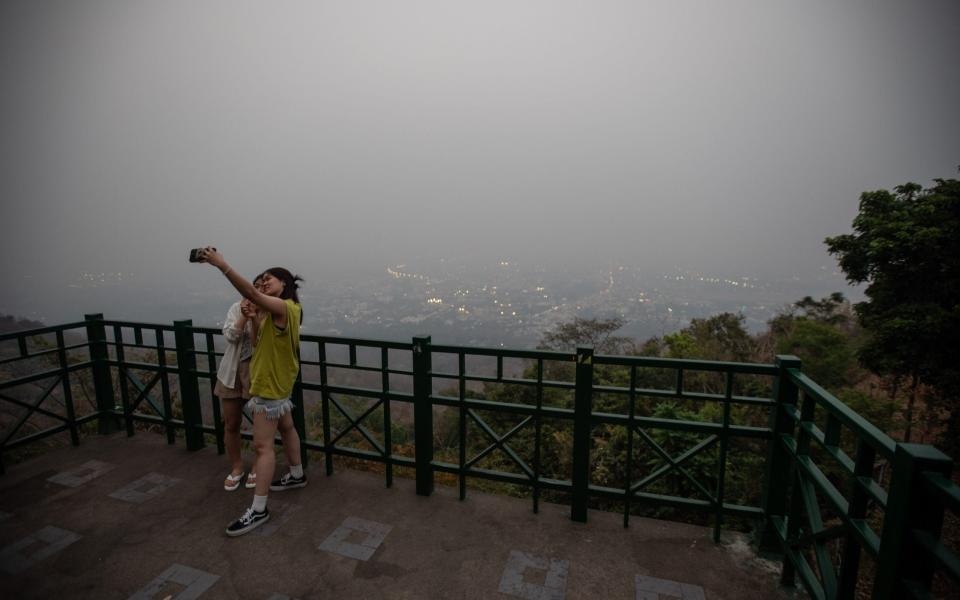Six years ago last April, I was lying on the stage of a community village hall on the outskirts of Chiang Mai and an old man massaged my back with his feet, which happened to be on fire.
This practice, known as yam kang, is one of several unusual treatments found only in and around Chiang Mai, the Thai city where mental and physical health is as ingrained in the culture as the roots of the banyan tree.
One of the world’s great wellness centers – along with Bali, Goa and Rishikesh – Chiang Mai is home to more than 300 Buddhist temples, hundreds of massage parlors, dozens of yoga retreats, and the largest school of traditional medicine. Thailand, which is part of the Faculty of Medicine of Chiang Mai University.
Throw in the bucolic countryside, with its hiking trails, elephant sanctuaries and river rafting, and it’s easy to see why this is a health hotspot. But an essential part of any spa break is the ability to, well, breathe – which is very difficult to do in Chiang Mai at the moment.
Tourists, along with a long-suffering local population of around 120,000, are currently reeling under pollution levels more than 20 times higher than World Health Organization (WHO) recommendations. According to the global air monitoring website IQAir, for the past few weeks Chiang Mai has regularly topped the charts as the world’s most polluted city, surpassing the likes of Delhi, Kolkata and Lahore.
The concentration of harmful PM 2.5 particles (2.5 micrometers or less in diameter) in the atmosphere peaked at 136.2 micrograms per cubic meter earlier this month. To provide some context, the current reading in London is 6.2, while the safe daily maximum recommended by the World Health Organization is 25.

Scientists have suggested that spending time in such a polluted environment is equivalent to smoking two packs of cigarettes a day.
Why is semi-rural Chiang Mai suffering so much? ‘Burning season’, a man-made environmental disaster that occurs every year, between the beginning of February and the end of April, when farmers – many working with large agricultural enterprises – use fire to clear land for the first sugar cycle or another rice crop.
Although the practice has been happening for years, experts say the intensity and length of the burning season has worsened.
Not long ago, spring was one of the best times to visit north-west Thailand, thanks to low humidity, little rain and cool nights – now is a time when the historic city, its golden stupas and the surrounding countryside in thick gray green. a smog blanket that is a health hazard.
“These figures – PM2.5 and PM10 – sound innocuous but most people don’t realize that these are tiny particles that cannot be inhaled,” explains built environment expert John Herbert. “If you’re exposed to these levels long-term, or even for a few months, you’re going to end up with serious respiratory disorders that could lead to hospitalization.”
Short-stay visitors can also be affected, with tourists reporting cases of runny eyes, nose irritation, skin rashes and breathing difficulties. “I would advise people not to go on holiday [to Chiang Mai] at this time of year,” says Herbert.
“Especially young people – children are 10 times more vulnerable – or anyone with a weakened immune system, asthma or any other respiratory problems. Fitness and PM2.5 reading of more than 200 [as has been seen in Chiang Mai] they are a clear contradiction.”


For those visiting, safety advice includes reducing outdoor exercise, keeping windows closed, wearing a mask and running air purifiers – hardly conducive to a spa break.
“The city’s recent ranking as the most polluted city, together with the media coverage it has received, has certainly had an impact on our business,” says Anchalika Kijkanakorn, founder and managing director of the AKARYN Hotel Group, which recently opened the Aleenta Retreat Chiang Mai. , a teakwood-winged rooftop escape offering traditional Thai therapies and world-class facilities on the edge of the city’s forests.
“As a retreat and wellness hotel our guests are made aware of the pollution and actively avoid visiting at this time of year. But to address the concerns [of those that do] we have fitted air purifiers to our guest rooms, as well as our spa, gym and bar, and are providing masks to both guests and staff.”
Improvements are promised. Concerns about the long-term health of local people and the negative impact on tourism eventually prompted Prime Minister Srettha Thavisin’s government to pass the Clean Air Act in January. Last week Chiang Mai governor Nirat Phongsitthithawon offered a more short-term solution, ordering authorities to use air purifiers to create clean air chambers that could provide temporary relief to locals.
However, although current levels have not reached the sky-high toxicity recorded in 2023, most believe that more decisive action is needed to support farmers and stop crop burning.
Until that day comes, the toxic clouds currently blinding the city will return every year, endangering the lives and livelihoods of Northern Thailand residents and visitors.